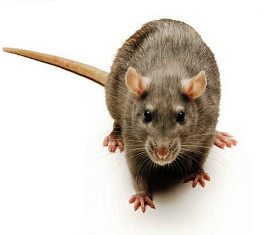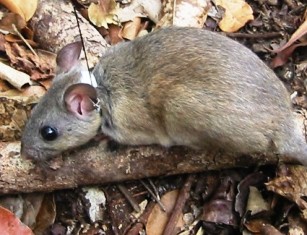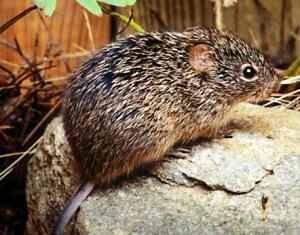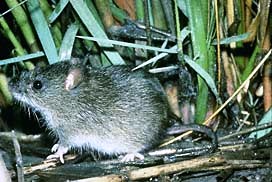Discover Florida Nature
It's time to explore the natural Florida


|
|
|
|
|
Rats are various medium-sized, long-tailed rodents of the superfamily
Muroidea. Rats are typically distinguished from mice
by their size; rats are generally large muroid rodents, while mice are
generally small muroid rodents. "True rats" are members of the genus
Rattus, the most important of which to humans are the black rat and
the brown rat. Brown
Rat-
The brown rat is found worldwide, with the exception of the polar
regions. It can survive in almost any environment, but it is most
commonly found near farms, in garbage dumps, and in sewers .The brown
rat is also called the sewer rat, the barn rat, and the Norwegian rat.
Brown rats are fairly husky, brownish rodents that weigh about 11
ounces. They are about 13 to 18 inches long including the 6 to 8 1/2
inch tail. Their fur is coarse and mostly brown with scattered black on
the upper surfaces. The underside is typically grey to yellowish-white.
It likes dense cover, where it will dig a series of linking burrows in
sloping ground in the side of a ditch. Brown rats also prefer to live
near water and is a good swimmer. The brown rat lives in colonies where
every member recognizes each other by smell. There is a social structure
in a colony, but the dominant rats are tolerant of others. The brown rat
feeds at night and sleeps through the day. It is most active at dawn and
dusk. Although its eyesight is poor, the brown rat has a very keen sense
of smell which it uses to locate food. The rat prefers to eat stored or
cultivated cereal grains but also eats meat. It eats various types of
poultry, including ducklings. Food is usually carried in its mouth to a
safe place where it is eaten. Large items are dragged to a hiding place.
The food the rat leaves uneaten is left behind since, unlike many
rodents, the brown rat does not hoard food. Brown
Rat-
The brown rat is found worldwide, with the exception of the polar
regions. It can survive in almost any environment, but it is most
commonly found near farms, in garbage dumps, and in sewers .The brown
rat is also called the sewer rat, the barn rat, and the Norwegian rat.
Brown rats are fairly husky, brownish rodents that weigh about 11
ounces. They are about 13 to 18 inches long including the 6 to 8 1/2
inch tail. Their fur is coarse and mostly brown with scattered black on
the upper surfaces. The underside is typically grey to yellowish-white.
It likes dense cover, where it will dig a series of linking burrows in
sloping ground in the side of a ditch. Brown rats also prefer to live
near water and is a good swimmer. The brown rat lives in colonies where
every member recognizes each other by smell. There is a social structure
in a colony, but the dominant rats are tolerant of others. The brown rat
feeds at night and sleeps through the day. It is most active at dawn and
dusk. Although its eyesight is poor, the brown rat has a very keen sense
of smell which it uses to locate food. The rat prefers to eat stored or
cultivated cereal grains but also eats meat. It eats various types of
poultry, including ducklings. Food is usually carried in its mouth to a
safe place where it is eaten. Large items are dragged to a hiding place.
The food the rat leaves uneaten is left behind since, unlike many
rodents, the brown rat does not hoard food. Florida
Woodrat-The Florida woodrat is grayish brown above, with white
or grayish underparts. It's bicolored tail is less than half total
length of the rat's total length of 12-17 inches. The Florida woodrat
weighs between seven and sixteen ounces. The Florida wood rat is found
southeastward through southern states to mid-peninsular Florida. The
Florida Woodrat feeds mostly on green vegetation, but also eats various
fruits, nuts, fungi, ferns, and seeds. A subspecies of the Florida
woodrat is the
Key Largo woodrat, an endangered species found only in the Florida
keys. Florida
Woodrat-The Florida woodrat is grayish brown above, with white
or grayish underparts. It's bicolored tail is less than half total
length of the rat's total length of 12-17 inches. The Florida woodrat
weighs between seven and sixteen ounces. The Florida wood rat is found
southeastward through southern states to mid-peninsular Florida. The
Florida Woodrat feeds mostly on green vegetation, but also eats various
fruits, nuts, fungi, ferns, and seeds. A subspecies of the Florida
woodrat is the
Key Largo woodrat, an endangered species found only in the Florida
keys.  Hispid
Cotton Rat- A Hispid Cotton Rat has a gray-enhanced coat of
deep-brown hair. Its underparts are gray or white and it has small ears.
A typical Hispid Cotton Rat resides in grasslands in the Southern United
States, Mexico, and Central America, including Florida. This diurnal
rodent feeds on green plants and eggs of ground-nesting birds. Its nests
on the ground or under it. Hispid Cotton Rats tend to move about using
the same routes, and distinct paths can be seen near their nests. They
move about in both nighttime and daytime, and Hispid Cotton Rats are
good swimmers. The cotton rat can reproduce all year round. The
gestation period lasts for four weeks, and each litter has 1 to 15
young. Young grow rapidly and may be weaned 10 to 15 days after birth,
so up to nine litters can be born in a single year. As a result, when
weather conditions are good, there can be a huge increase in the rat
population causing severe damage to sugarcane, corn, and other crops. Hispid
Cotton Rat- A Hispid Cotton Rat has a gray-enhanced coat of
deep-brown hair. Its underparts are gray or white and it has small ears.
A typical Hispid Cotton Rat resides in grasslands in the Southern United
States, Mexico, and Central America, including Florida. This diurnal
rodent feeds on green plants and eggs of ground-nesting birds. Its nests
on the ground or under it. Hispid Cotton Rats tend to move about using
the same routes, and distinct paths can be seen near their nests. They
move about in both nighttime and daytime, and Hispid Cotton Rats are
good swimmers. The cotton rat can reproduce all year round. The
gestation period lasts for four weeks, and each litter has 1 to 15
young. Young grow rapidly and may be weaned 10 to 15 days after birth,
so up to nine litters can be born in a single year. As a result, when
weather conditions are good, there can be a huge increase in the rat
population causing severe damage to sugarcane, corn, and other crops.
 Marsh
Rice Rat- The marsh rice rat is a medium-sized generalized rat
with a total length of 226-305 mm and a weight of 45-80 grams. The
dorsal coloration varies from gray to grayish brown and the underparts
including the tail and feet are much lighter. The underfur is dense,
soft, and water repellent. The breeding season occurs year round and
several litters of 1-6 young are born per year. This species is
nocturnal and will enter the water and swim for distances greater than
10 meters. The nests are grapefruit-size of woven grasses and sedges.
They are usually placed on high ground under debris, at the base of
shrubs, or at the end of shallow burrows. Owls are a major predator.
They frequently coexist with hispid cotton rats and meadow voles. This
is an opportunistic feeder and it will eat whatever is available,
including insects, fiddler crabs, and snails. They are considered a
major predator on the eggs and young of long-billed marsh wrens. Marsh
Rice Rat- The marsh rice rat is a medium-sized generalized rat
with a total length of 226-305 mm and a weight of 45-80 grams. The
dorsal coloration varies from gray to grayish brown and the underparts
including the tail and feet are much lighter. The underfur is dense,
soft, and water repellent. The breeding season occurs year round and
several litters of 1-6 young are born per year. This species is
nocturnal and will enter the water and swim for distances greater than
10 meters. The nests are grapefruit-size of woven grasses and sedges.
They are usually placed on high ground under debris, at the base of
shrubs, or at the end of shallow burrows. Owls are a major predator.
They frequently coexist with hispid cotton rats and meadow voles. This
is an opportunistic feeder and it will eat whatever is available,
including insects, fiddler crabs, and snails. They are considered a
major predator on the eggs and young of long-billed marsh wrens. |
|
|
Advertise | Privacy Statement | Dog Encyclopedia | Video |Contact | Alaska Nature |
|